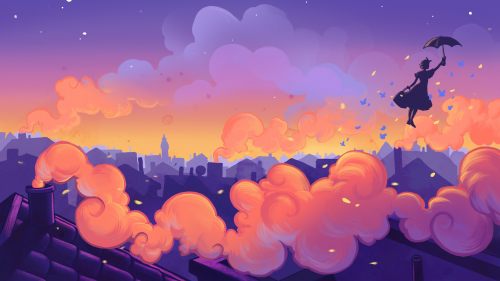MARY POPPINS RETURNS Review: This Movie Needs A Nanny’s Firm Hand
Don't forget to buy your copy of the Disney Live-Action Commemorative Issue of Birth.Movies.Death.!
Perhaps the most notable accomplishment in Mary Poppins Returns is that the film bends a thin premise into an excuse for this sequel to exist in the first place. It’s an airy confection with no real weight or point of view, despite multiple songs emphasizing the value of finding a new perspective. I guess a fresh way of looking at things, in this case, is that a sequel to Mary Poppins might not be wholly unnecessary, if you just squint and twist and maybe stand on your head. So when the lamplighter Jack, played by Hamilton sensation Lin-Manuel Miranda, opens the film singing about “the lovely London sky” below a wan, ashen firmament, it’s a bit of irony. It’s like the film itself is playing Mary Poppins with a shrug. “This is going to happen one way or another, might as well make the best of it.”
Director/choreographer Rob Marshall and his team do mostly make the best of it. That includes hiring Emily Blunt, whose ability to turn a stern glance into a conspiratorial wink captures just enough of the essence of Poppins. She’s smartly paired with Miranda, who projects such guileless good nature that he could be prescribed as a medical cure for cynicism.
Screenwriter David Magee turns the clock forward a couple decades from the period of the first movie to the London of “the Great Slump.” The only real evidence of depression, however, is that the Banks family is on the brink of financial ruin. That problem isn’t even quite tied to the world’s troubles, but to Michael Banks’s own personal shortcomings. He was never good with money — he’s an artist, the only evidence of which is a few cast-off drawings — and in the wake of his wife’s death, things have really gone to pot.
Michael Banks is played by the winsome Ben Whishaw, wearing a ridiculous mustache and slightly oversized costume, both of which emphasize the idea that Banks is just a large child. Whishaw is charming enough that Michael’s general lack of discernable character doesn’t become a problem until the film is well into its second hour. (And I only thought of Paddington two or three times.)
Mary Poppins Returns is such a fantasy that quibbling too much about plot seems entirely beside the point. Mostly it cruises along hitting the occasional high point when it’s time for a new cameo — like Meryl Streep as a distant Poppins relative, playing her role like a Hayao Miyazaki witch dropped into a Broadway musical — or any moment that allows Blunt or Miranda to turn on their high-wattage star power.
One such sequence is ‘A Cover Is Not the Book,’ an uptempo vaudeville number with just a hint of bump and grind, sung from within a ceramic bowl that becomes an animated fantasyland. This is one of a few chances for Blunt to make the character her own, and for Miranda to do what Hamilton long ago proved he does best. Their performances bring the movie to life. The sequence doesn’t exactly feel like it could be part of the original Mary Poppins — and that might be why there isn’t more stuff like it in the new movie.
In fact, ‘A Cover Is Not the Book’ points to the primary problem with Mary Poppins Returns, which is that it focuses far more on “Mary Poppins” than “Returns.” The 1964 film is used as a template to which the new movie strictly adheres. There’s the live-action/animated sequence, a lamplighter’s dance, a side-pot visit to an upside-down location, and so on. No songs are precisely repeated, possibly because that would limit the film’s Oscar chances, but that doesn’t reduce the impression that this movie has been traced over the old.
Fantasy and whimsy become a lot less fantastic and whimsical when copied and repeated. The original film, with its effects and animation, felt like a sales pitch for what Disney could do. This sequel is an acknowledgment that audiences want something the studio no longer creates. The remedy, of course, is simple: make more movies like Mary Poppins — but perhaps not more movies that are as exactly like Mary Poppins as possible. Doing that only ensures that the cover actually is the book.



